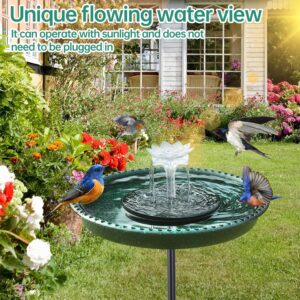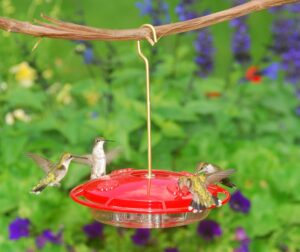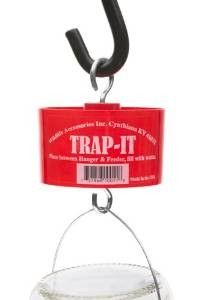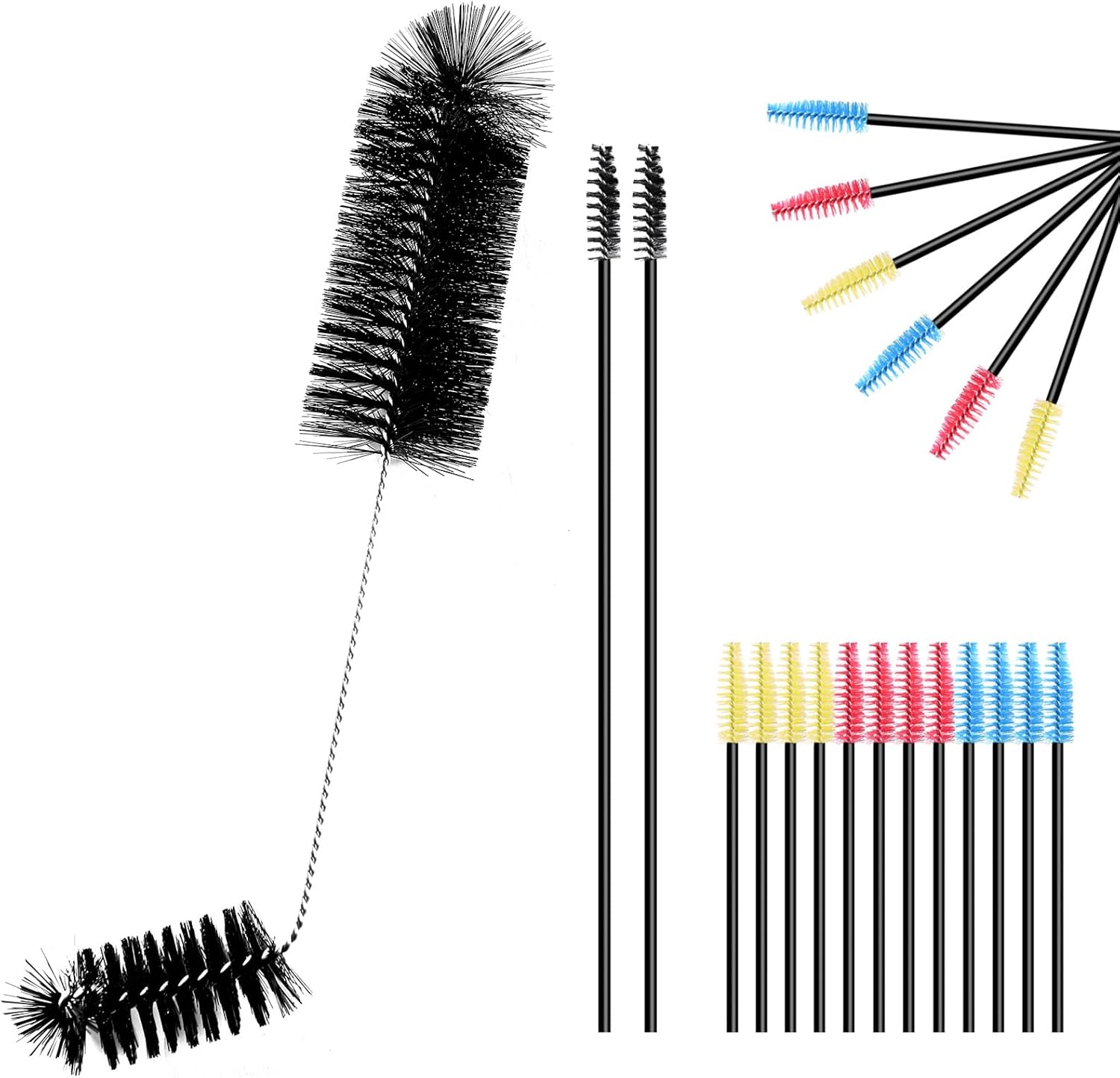Here you will learn all about what hummingbirds eat and you will learn how to make a hummingbird nectar recipe.
Hummingbirds eat up to their body weight each day when they are fattening up getting ready for the fall migration.
Do hummingbirds eat seeds?….no.
Hummingbirds have specialized beaks for feeding on liquid and do not have the physical adaptations necessary to consume or digest seeds.
Do hummingbirds eat only flower nectar?….no.
They primarily feed on nectar from flowers, which provides them with the sugars they need for energy. In addition to nectar, they may also consume small insects, spiders, and other tiny invertebrates to get protein and other nutrients.
Do hummingbirds eat ants?….yes
 Hummingbirds sometimes eat ants, though it’s not their primary food source. Their diet mainly consists of nectar from flowers and small insects, like spiders or fruit flies, which provide essential proteins.
Hummingbirds sometimes eat ants, though it’s not their primary food source. Their diet mainly consists of nectar from flowers and small insects, like spiders or fruit flies, which provide essential proteins.
Ants might be consumed for a few reasons:
- Protein: Insects, including ants, provide proteins and amino acids that are essential for hummingbirds’ muscle development and overall health.
- Variety: Eating ants or other small insects adds diversity to their diet, especially during times when nectar may be scarce or when they need extra energy.
- Ants as a food source: Sometimes ants are abundant in areas where hummingbirds feed, and they might accidentally consume them while foraging for nectar or insects.
So while not a major part of their diet, ants help hummingbirds meet their nutritional needs.
Do hummingbirds eat bugs?….yes
They also eat small spiders, and some species feed on tree sap from holes in trees that other birds have made such as yellow bellied sap suckers. Sapsucker holes are a double treat, providing both insects and sap! Yes, hummingbird do eat bugs and hummingbirds do eat ants and they also eat small insects such as mosquitoes, aphids, gnats, midges, caterpillars, flying ants, weevils, small beetles, white flies and insect eggs.
Hummingbirds require lots of energy, since they have the fastest wing beats of any bird, around. Their wings beat around 70 beats per second and up to 200 beats per second during a high speed dive. Also, a hummingbird’s heart beats up to 1,260 beats per minute. All of that takes a lot of energy.
So to summarize about what hummingbirds eat, they feed mostly on flower nectar, but they also eat small insects and spiders to get protein and a few feed on tree sap.

Besides nectar and insects, hummingbirds also need water
Hummingbirds primarily get their hydration from nectar, which provides both sugar for energy and some water. However, they still need to drink water to stay fully hydrated, especially during hot weather or periods of high activity. While nectar is their main source of liquid, they will occasionally sip from other water sources, such as puddles, ponds, or droplets on leaves, to supplement their hydration.
In a garden setting, you can help by providing a clean, shallow water source like a bird bath or misting plants, which hummingbirds may enjoy. To help provide water to your hummingbirds, check out Amazon’s hummingbird misters and bird baths
What do baby hummingbirds eat?
Baby hummingbirds primarily eat nectar and insects, but their diet is different from adult hummingbirds in a few key ways.
- Nectar: Baby hummingbirds depend on their mothers to feed them by transferring nectar directly from their beaks. Nectar provides them with essential sugars for energy and growth.
- Insects and Spider Silk: In addition to nectar, baby hummingbirds consume small insects like ants, aphids, and fruit flies, as well as spider silk. These provide much-needed protein, fats, and essential nutrients for their development.
Initially, the mother hummingbird will feed the babies several times a day by regurgitating a mixture of nectar and insects into their open mouths, often keeping them well-fed for rapid growth. As the babies mature, they gradually start to feed themselves.
How often do hummingbirds eat?
Because of their high energy requirements spent flying, they must feed continuously during their waking hours. Hummingbirds have the highest metabolism of any animal on earth. Their high energy requirements cause them to eat more than they weigh each and every day.
metabolism of any animal on earth. Their high energy requirements cause them to eat more than they weigh each and every day.
Because of their extremely high metabolism, hummingbirds will have to feed often, every 10 to 15 minutes when they are active.
In addition to nectar, which provides them with carbohydrates, they also eat small insects and spiders for protein, fats, vitamins, and minerals. During the night, hummingbirds enter a state of torpor, significantly lowering their metabolic rate to conserve energy.
More on what hummingbirds eat :
Hummingbirds get nectar from flower blossoms and sometimes eat the insects that they find in the blossoms and have been known to pick insects out of spider webs. About a third of their diet consists of small insects and spiders which they sometimes catch in mid-air. These small bugs and spiders that they catch provide the protein content they need.
Now that your question, what do hummingbirds eat and how often do hummingbirds eat, has been answered, you might want to put out a feeder and feed your own hummingbirds. Below is the best hummingbird feeder you can get:

My favorite Hummingbird nectar feeder is Aspects 12oz Hummzinger Ultra With Nectar Guard .
The HummZinger has patented Nectar guard tips which are flexible membranes attached to the feed ports that prohibit entry from flying insects, but allow hummingbirds to feed as usual. The HummZinger also has a built in ant moat that will stop crawling insects from getting to the nectar. It also has raised flower ports that divert rain.
This mid-size nectar feeder has a 12 oz. capacity and can be hung or post mounted with hardware provided. It has four feeding ports and is made of unbreakable polycarbonate. Easy to clean.
For ease of cleaning and protection from bees, wasps and ants, this feeder can’t be beat.
If you already have a hummingbird feeder, and you want to protect it from ants and other crawling insects, the ant moat below will keep crawling insects out of your nectar
Trap-It Ant Moat for Hummingbird Feeders
Using an ant moat for your hummingbird feeder is an effective way to keep ants away from the sweet nectar. These tiny creatures are drawn to

the sugar water, and without a barrier, they will quickly infest your feeder, preventing the birds from enjoying the nectar. An ant moat works by creating a barrier of water that ants can’t cross. Positioned above the feeder, it effectively blocks the ants’ path, keeping them from reaching the nectar.
This simple solution also ensures that your hummingbird feeder remains clean and accessible for the birds, rather than becoming a breeding ground for ants or other pests. It’s a small addition that can make a big difference in maintaining a healthy, inviting space for hummingbirds, while also reducing the need for chemical ant deterrents.
The first and still the best to protect your Hummingbird and Oriole feeder from ants and other crawling insects. Insert between hanger and feeder and fill with water, providing a barrier to crawling pests. Red color to attract hummingbirds.
Hummingbird nectar mixture
 |
A good set of small hummingbird feeder brushes is invaluable and will save lots of time, when it comes to keeping your feeder clean.
Product Description
Features: You should wash your feeder every time you refill it. Mold and dirt can build up quickly and can be harmful. Brushes are great for stubborn spots and hard to reach areas. Includes 3 brushes to clean every part of your hummingbird feeder. Brushes clean the stems or opening of the feeder flowers and the sides and bottom of the nectar bottles. |
Video making hummingbird food
When to stop feeding hummingbirds
In colder climates or northern regions, it is often recommended to stop feeding around late September to early October after the local  hummingbird species have migrated south. This is because most hummingbirds (like the Ruby-throated Hummingbird) migrate to warmer areas in the fall, and continuing to feed them can interfere with their natural migratory patterns.
hummingbird species have migrated south. This is because most hummingbirds (like the Ruby-throated Hummingbird) migrate to warmer areas in the fall, and continuing to feed them can interfere with their natural migratory patterns.
In milder climates, especially where hummingbirds may overwinter, you can continue feeding them through the winter. In these areas, some species might remain year-round if the weather is not too harsh.
- Monitor Activity: You can stop feeding once you notice that the hummingbirds stop visiting your feeders. As they approach migration time, their visits will gradually decrease. If you are unsure, it’s safer to keep the feeders up until late October to early November.
- Preventing Dependency: Hummingbirds will naturally find other food sources as they prepare to migrate, so there is little risk of making them dependent on feeders. However, if you’re concerned about keeping them from getting lost, it’s good practice to keep food available for them until they are no longer showing up regularly.
In any case, it’s essential to clean your feeders regularly.
Click on the link Hummingbird Feeding to learn when to start feeding hummingbirds, when to stop feeding hummingbirds and everything you need to know about feeding your hummingbirds.
I hope you enjoyed this article on “what do hummingbirds eat?” If you found this article helpful, don’t keep it to yourself! Share the love by using the social bookmarking buttons on the left side of the page. Help spread the joy of hummingbirds and inspire others to enjoy these amazing creatures. Let’s make the world a little brighter—for the hummingbirds and for everyone else! Do it for the birds!
Hummingbird Resources
U.S. Fish and Wildlife Service – Hummingbird Conservation
This site offers detailed information about various hummingbird species, their habitats, and conservation efforts. It also provides resources on how to protect these fascinating birds.
National Park Service – Hummingbird Resources
The National Park Service offers insights into hummingbird species found in national parks, their behaviors, and their role in ecosystems, along with tips for observing them.
Smithsonian National Museum of Natural History – Birds: Hummingbirds
This resource provides educational materials on the role of hummingbirds in pollination and biodiversity, backed by scientific research and exhibits from the Smithsonian.


